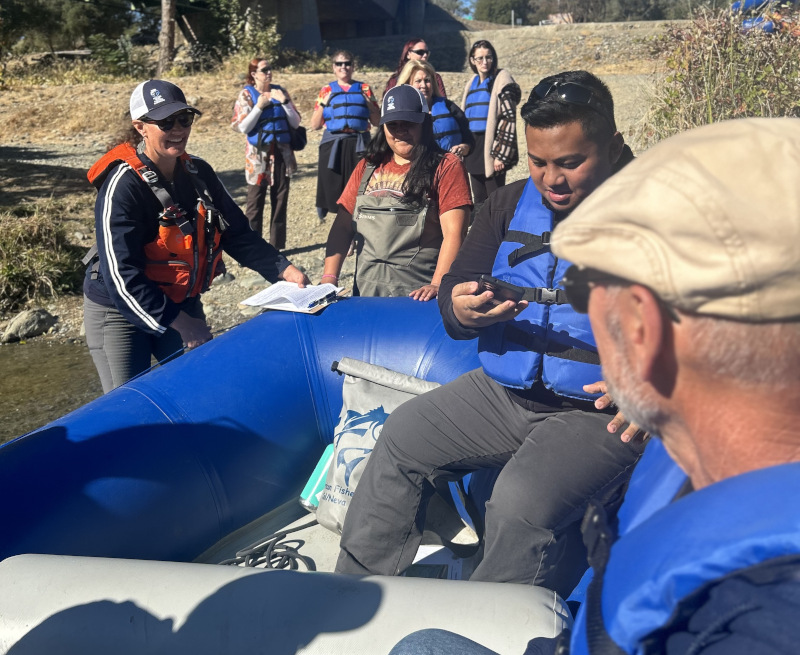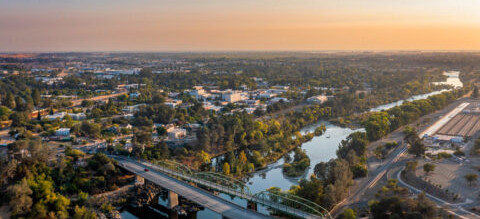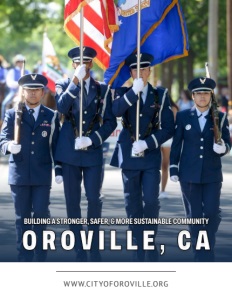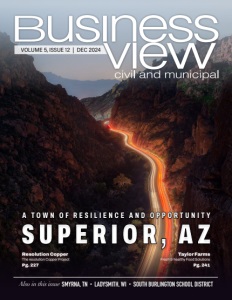Oroville, California
Building a Stronger, Safer, and More Sustainable Community
A thriving hub that blends historical charm with modern opportunity and ambitious plans for infrastructure, housing, and clean energy.
Oroville, California, the county seat of Butte County, California, is about 70 miles north of Sacramento, where the Sacramento Valley meets the Sierra Nevada foothills. Originally a Gold Rush settlement, it’s a diverse and burgeoning community today. Known for its scenic waterways and proximity to outdoor adventure and urban amenities, its relatively affordable cost of living compared to much of California appeals to families, entrepreneurs, and established industries.
“Our community has been around a long time,” says Mayor David Pittman, proud of Oroville’s roots. “There’s a lot of history here.” A sense of place runs deep in Oroville, where natural resources and historical landmarks form the backbone of local identity. Five major bodies of water define the area and make it unique. “There’s not many places that can speak to that,” the mayor adds, pointing out the rare combination of lakes and rivers that support recreation and industry.
Oroville’s business-friendly environment is another point of pride for Mayor Pittman. “We’re always looking for new business and investment,” he says, describing the city’s willingness to accommodate companies that show interest in the area. One notable success story is the Pacific Coast Producers cannery, which plays a central role in the local economy. “Almost all the fruit cocktails canned in the world are canned here in Oroville,” he notes. Over the years, this facility has employed thousands.
The city’s accessibility has improved recently with the expansion of State Highway 70 to a five-lane route connecting Oroville to Sacramento. “Commercial transport is now a common item here,” Mayor Pittman explains, pointing out that the enhanced highway has opened new business logistical pathways. Along with Highway 99, the city’s infrastructure allows businesses easy access to major markets while preserving the small-town feel. For residents, this connectivity means outdoor activities—from snow sports to coastal excursions—are just a couple of hours away.
Revitalizing Downtown Oroville
Oroville’s downtown core, defined by the historic charm of Montgomery Street and its proximity to the Feather River, is undergoing significant revitalization. This initiative, led by city officials, beautifies the area and improves safety. “We’re about to start work on our main road, Montgomery Street, which runs right through the heart of downtown,” says City Administrator Brian Ring.
In the next few months, the city will undertake restriping along this central artery, incorporating traffic-calming measures expected to make it a safer, more accessible route for everyone. “It’s going to add to the beauty of downtown,” he adds, noting that the changes will complement existing recreational areas nearby.
According to Community Development Director Patrick Piatt, the downtown area is “really quite photogenic,” with a mix of restaurants, Victorian-era architecture, and historic buildings that bring character and warmth to the streets. Preserving these original structures is central to Oroville’s identity, allowing the city to retain a sense of continuity with its past.
Ring adds that five major museums are located close to Montgomery Street. These include the Lott Home, an elegant Victorian residence; the Chinese Temple, an iconic site dating back to the 1850s; and the Pioneer Museum, which celebrates Oroville’s frontier spirit.
“We even have a green line painted on the roadway,” Mayor Pittman notes with a smile, “so you can follow it to whichever site you want to see.” This green line leads visitors to the Oroville Dam, the tallest dam in the United States, just a few miles from downtown.
Local Innovation
Oroville’s growth strategy is as much about empowering residents and local businesses as it is about attracting outside investment. One of Oroville’s latest innovations is a user-friendly, web-based platform that simplifies the planning process for residents and entrepreneurs.
“We just bought a software program that allows people to go through a decision tree to map out projects—whether it’s adding a room to a house, building a home, or starting a business,” explains Piatt. The tool demystifies the approval process, giving users a clear idea of costs, requirements, and timelines. “This way, people can start thinking about what they want to do without having to come into city hall, which can often feel intimidating,” he adds. Oroville hopes to encourage more residents to pursue development projects by making city processes more accessible in this way.
Another project with a significant community impact is Oroville’s “Civic 101” program, an educational initiative that introduces how the city functions to bridge gaps between different parts of the community. Piatt explains that one neighborhood, annexed into the city in 2015, has historically felt isolated. “We’re just now kicking off a program in that area, working with residents to help them build community themselves, with us providing guidance and support,” he says. This initiative is part of a broader effort to ensure all residents feel connected and invested in Oroville’s future.

Workforce Development
Oroville’s focus on education goes beyond community-building efforts; it also includes vocational training tailored to the needs of local industries. The city has partnered with Butte College to develop a satellite campus offering cybersecurity, IT, and robotics programs. “Our industries—like the metalworks, wood manufacturing, and fruit production companies—all use robotics, so we want to train local people to fill those roles,” Piatt says, adding that the goal is to create a steady pipeline of skilled workers, ensuring that jobs stay local.
Sustainability also plays a central role in Oroville’s plans. The city is set to become a hub for biomass energy production because of a vast amount of timber from recent wildfires and forest management efforts. “There’s an unimaginable amount of wood coming down from the mountains,” Piatt says, explaining that three biomass companies are about to open in Oroville. Converting this surplus timber into energy will prevent the city from decaying and releasing carbon back into the atmosphere, creating a “negative balance” for carbon emissions and helping reduce the area’s environmental footprint.
Mayor Pittman emphasizes Oroville’s strategic location for biomass facilities, noting that the city already has the electrical infrastructure to support these operations. “We’re centrally located to bring fuel out of the mountains to these facilities, plus we have a good partnership with PG&E,” he says. PG&E’s presence also includes the new Oroville Assessment Center that certifies tree service contractors. The first and only facility in the Utility industry that ensures competency of utility contractors and equipment.
Residential Growth and Infrastructure Upgrades
As Oroville continues to attract residents and businesses, city officials are focusing on expanding housing options and bolstering infrastructure to accommodate this growth. According to Ring, there has been a surge in affordable apartment complexes in recent years, but the emphasis is now shifting.
“We’re focusing more on market-rate apartments and single-family homes,” he says, describing the city’s vision for a balanced housing market. Several approved subdivisions are primed for development West of Oroville, near the airport and across the Feather River. “Some are already under construction,” Ring notes, pointing to a 200-lot project underway and another 250-lot development just south of town. The city’s infrastructure is prepared to support this growth, with recent upgrades to the sewer system doubling its pump capacity.
Mayor Pittman highlights Oroville’s proactive approach to infrastructure. “We’ve planned ahead,” he says confidently, noting the recent expansion of the local hospital will attract healthcare professionals. Piatt echoes this sentiment, mentioning that the city has several thousand entitled lots ready for development. Within the next year and a half, he expects several hundred new homes to be built. Piatt also mentions a major mixed-use project on the horizon—a planned development with 1,700 homes and a commercial component.
Oroville’s appeal is multi-dimensional. For those seeking a more rural lifestyle, the surrounding areas offer spacious ranchettes where residents can enjoy a few acres of land. “We’re a central hub for smaller communities like Honcut, Bangor, Feather Falls, and Berry Creek,” says Mayor Pittman. These areas draw people looking to combine family life with outdoor space, often choosing properties that support activities like horseback riding or small-scale farming.
Regarding zoning flexibility, the city allows accessory dwelling units (ADUs), allowing homeowners to add secondary residences to their properties. “If someone wants to build an ADU and meets the setbacks, it’s already permitted,” says Piatt. The city’s “business-friendly” approach includes a design review committee that engages with developers and residents early in the process. “I encourage people to meet with the whole team—engineers, planners, and building examiners—so we can discuss their project and help them overcome challenges,” he explains.
Oroville is additionally working to ensure its residents and businesses have access to high-speed internet. Mayor Pittman elaborates on the city’s current connectivity. “Most of our residential areas already have fiber on poles, and Comcast service is strong,” he notes. However, the business and industrial areas have lagged in fiber access, a gap the city is actively working to address. Oroville’s location on a major fiber optic route—aligned with the railroad right-of-way—gives it unique connectivity advantages. “We have a 60,000-square-foot underground storage facility here that supports major fiber optic infrastructure for the West Coast,” Pittman says.

Priorities for a Thriving Future
As Oroville looks to the years ahead, city leaders are focused on infrastructure, community safety, and economic opportunities. For Ring, infrastructure remains a central priority. “Reinforcing the roads, curbs, gutters, and sidewalks is key,” he says. Over the years, Oroville’s expansion through annexation has brought new neighborhoods into the fold, but it’s also created a backlog of infrastructure needs. Bringing these areas up to standard is crucial for supporting further growth and ensuring that all residents experience a high quality of life.
Piatt has his eye on expanding Oroville’s role as a center for alternative energy. With a cluster of biomass companies already setting up operations, the city is taking the mantle of a regional leader in sustainable energy production. “We’d like to see another biomass facility come in,” he says, noting that co-locating these companies in one area allows them to support one another and optimize resources. Beyond alternative energy, Piatt is passionate about cultivating a “common cultural experience” across Oroville, bridging different neighborhoods and backgrounds through shared events, spaces, and initiatives.
For Mayor Pittman, safety and security top the agenda. He’s proud of Oroville’s recent investment in public safety technology, including deploying the Flock camera system and mobile camera trailers to address crime hotspots. “We’re very interested in expanding the technology of law enforcement throughout our community,” he says. Another focus area is infrastructure, with the mayor stressing the importance of ensuring utilities can support new housing developments. “When we add new housing, we need to be sure our utilities are ready for those connections,” he explains.
Financial stability will continue playing a significant role; Mayor Pittman proudly notes that Oroville maintains a 30% reserve fund, a financial cushion that gives the city flexibility and resilience in uncertain times. “Not many communities in California can say that,” he adds. Finally, education remains a critical piece of Oroville’s long-term vision. “Partnerships with the local school system, along with our charter schools, are going to be the strength of our community,” concludes the mayor, demonstrating that Oroville is prepared to grow while preserving its unique qualities
AT A GLANCE
Oroville
What: An historic city focused on growth through infrastructure, housing, and sustainable energy initiatives
Where: Butte County, Northern California
Website: https://www.cityoforoville.org



